2004 ISUZU TF SERIES coolant temperature
[x] Cancel search: coolant temperaturePage 1487 of 4264
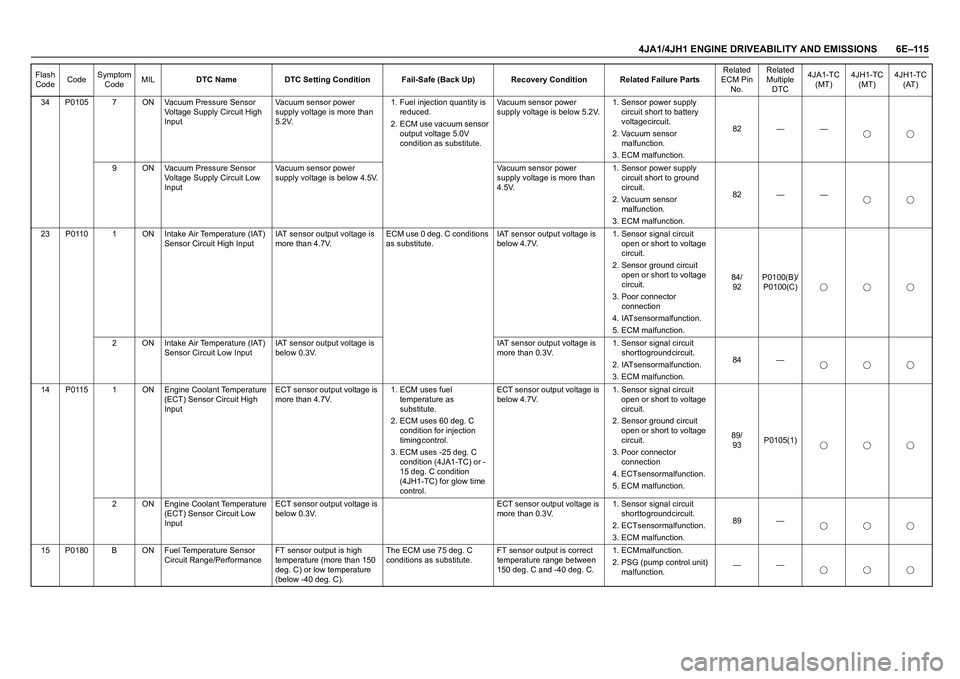
4JA1/4JH1 ENGINE DRIVEABILITY AND EMISSIONS 6E–115
34 P0105 7 ON Vacuum Pressure Sensor
Voltage Supply Circuit High
InputVacuum sensor power
supply voltage is more than
5.2V.1. Fuel injection quantity is
r e d u c e d .
2. ECM use vacuum sensor
output voltage 5.0V
condition as substitute.Vacuum sensor power
supply voltage is below 5.2V.1. Sensor power supply
circuit short to battery
voltage circuit.
2. Vacuum sensor
m a l f u n c t i o n .
3. ECM malfunction.82 — —
9 ON Vacuum Pressure Sensor
Voltage Supply Circuit Low
InputVacuum sensor power
supply voltage is below 4.5V.Vacuum sensor power
supply voltage is more than
4.5V.1. Sensor power supply
circuit short to ground
c i r c u i t .
2. Vacuum sensor
m a l f u n c t i o n .
3. ECM malfunction.82 — —
23 P0110 1 ON Intake Air Temperature (IAT)
Sensor Circuit High InputIAT sensor output voltage is
more than 4.7V.ECM use 0 deg. C conditions
as substitute.IAT sensor output voltage is
below 4.7V.1. Sensor signal circuit
open or short to voltage
c i r c u i t .
2. Sensor ground circuit
open or short to voltage
c i r c u i t .
3. Poor connector
c o n n e c t i o n
4. IAT sensor malfunction.
5. ECM malfunction.8 4 /
92P0100(B)/
P0100(C)
2 ON Intake Air Temperature (IAT)
Sensor Circuit Low InputIAT sensor output voltage is
below 0.3V.IAT sensor output voltage is
more than 0.3V.1. Sensor signal circuit
short to ground circuit.
2. IAT sensor malfunction.
3. ECM malfunction.84 —
14 P0115 1 ON Engine Coolant Temperature
(ECT) Sensor Circuit High
InputECT sensor output voltage is
more than 4.7V.1. ECM uses fuel
temperature as
s u b s t i t u t e .
2. ECM uses 60 deg. C
condition for injection
t i m i n g c o n t r o l .
3. ECM uses -25 deg. C
condition (4JA1-TC) or -
15 deg. C condition
(4JH1-TC) for glow time
control.ECT sensor output voltage is
below 4.7V.1. Sensor signal circuit
open or short to voltage
c i r c u i t .
2. Sensor ground circuit
open or short to voltage
c i r c u i t .
3. Poor connector
c o n n e c t i o n
4. ECT sensor malfunction.
5. ECM malfunction.8 9 /
93P0105(1)
2 ON Engine Coolant Temperature
(ECT) Sensor Circuit Low
InputECT sensor output voltage is
below 0.3V.ECT sensor output voltage is
more than 0.3V.1. Sensor signal circuit
short to ground circuit.
2. ECT sensor malfunction.
3. ECM malfunction.89 —
15 P0180 B ON Fuel Temperature Sensor
Circuit Range/PerformanceFT sensor output is high
temperature (more than 150
deg. C) or low temperature
(below -40 deg. C).The ECM use 75 deg. C
conditions as substitute.FT sensor output is correct
temperature range between
150 deg. C and -40 deg. C.1 . E C M m a l f u n c t i o n .
2. PSG (pump control unit)
malfunction.—— Flash
CodeCodeSymptom
CodeMILDTC Name DTC Setting Condition Fail-Safe (Back Up) Recovery Condition Related Failure PartsRelated
ECM Pin
No.Related
Multiple
DTC4JA1-TC
(MT)4JH1-TC
(MT)4JH1-TC
(AT)
Page 1489 of 4264
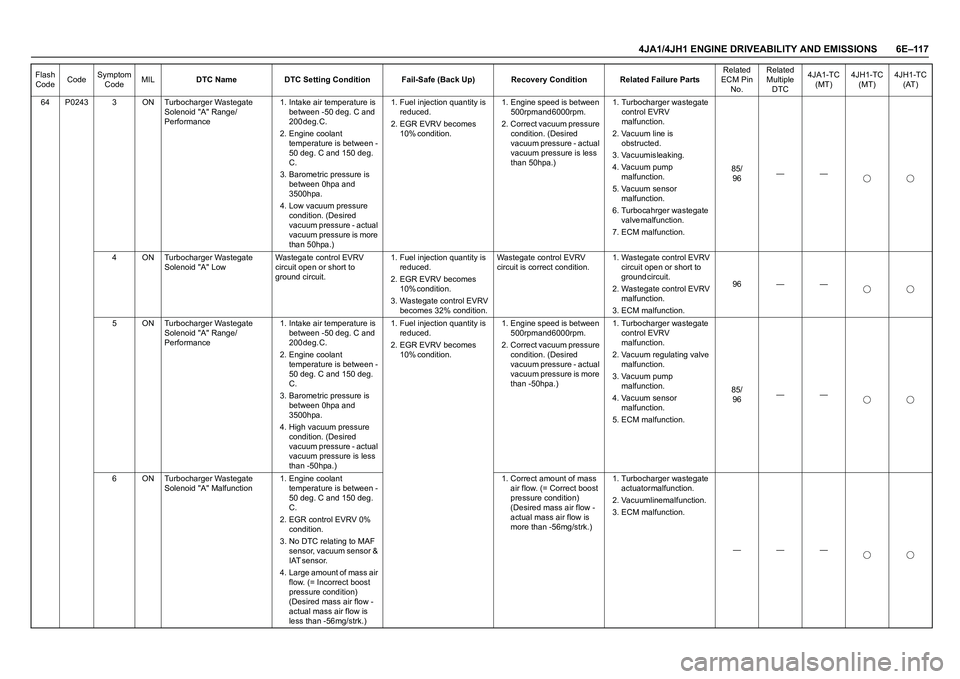
4JA1/4JH1 ENGINE DRIVEABILITY AND EMISSIONS 6E–117
64 P0243 3 ON Turbocharger Wastegate
Solenoid "A" Range/
Performance1. Intake air temperature is
between -50 deg. C and
2 0 0 d e g . C .
2. Engine coolant
temperature is between -
50 deg. C and 150 deg.
C .
3. Barometric pressure is
between 0hpa and
3 5 0 0 h p a .
4. Low vacuum pressure
condition. (Desired
vacuum pressure - actual
vacuum pressure is more
than 50hpa.)1. Fuel injection quantity is
r e d u c e d .
2. EGR EVRV becomes
1 0 % c o n d i t i o n . 1. Engine speed is between
500rpm and 6000rpm.
2. Correct vacuum pressure
condition. (Desired
vacuum pressure - actual
vacuum pressure is less
than 50hpa.)1. Turbocharger wastegate
control EVRV
m a l f u n c t i o n .
2. Vacuum line is
o b s t r u c t e d .
3. Vacuum is leaking.
4. Vacuum pump
m a l f u n c t i o n .
5. Vacuum sensor
m a l f u n c t i o n .
6. Turbocahrger wastegate
v a l v e m a l f u n c t i o n .
7. ECM malfunction.8 5 /
96——
4 ON Turbocharger Wastegate
Solenoid "A" Low Wastegate control EVRV
circuit open or short to
ground circuit.1. Fuel injection quantity is
r e d u c e d .
2. EGR EVRV becomes
1 0 % c o n d i t i o n .
3. Wastegate control EVRV
becomes 32% condition.Wastegate control EVRV
circuit is correct condition.1. Wastegate control EVRV
circuit open or short to
g r o u n d c i r c u i t .
2. Wastegate control EVRV
m a l f u n c t i o n .
3. ECM malfunction.96 — —
5 ON Turbocharger Wastegate
Solenoid "A" Range/
Performance1. Intake air temperature is
between -50 deg. C and
2 0 0 d e g . C .
2. Engine coolant
temperature is between -
50 deg. C and 150 deg.
C .
3. Barometric pressure is
between 0hpa and
3 5 0 0 h p a .
4. High vacuum pressure
condition. (Desired
vacuum pressure - actual
vacuum pressure is less
than -50hpa.)1. Fuel injection quantity is
r e d u c e d .
2. EGR EVRV becomes
1 0 % c o n d i t i o n . 1. Engine speed is between
500rpm and 6000rpm.
2. Correct vacuum pressure
condition. (Desired
vacuum pressure - actual
vacuum pressure is more
than -50hpa.)1. Turbocharger wastegate
control EVRV
m a l f u n c t i o n .
2. Vacuum regulating valve
m a l f u n c t i o n .
3. Vacuum pump
m a l f u n c t i o n .
4. Vacuum sensor
m a l f u n c t i o n .
5. ECM malfunction.8 5 /
96——
6 ON Turbocharger Wastegate
Solenoid "A" Malfunction1. Engine coolant
temperature is between -
50 deg. C and 150 deg.
C .
2. EGR control EVRV 0%
c o n d i t i o n .
3. No DTC relating to MAF
sensor, vacuum sensor &
I A T s e n s o r .
4. Large amount of mass air
flow. (= Incorrect boost
pressure condition)
(Desired mass air flow -
actual mass air flow is
less than -56mg/strk.)1. Correct amount of mass
air flow. (= Correct boost
pressure condition)
(Desired mass air flow -
actual mass air flow is
more than -56mg/strk.)1. Turbocharger wastegate
a c t u a t o r m a l f u n c t i o n .
2. Vacuum line malfunction.
3. ECM malfunction.
——— Flash
CodeCodeSymptom
CodeMILDTC Name DTC Setting Condition Fail-Safe (Back Up) Recovery Condition Related Failure PartsRelated
ECM Pin
No.Related
Multiple
DTC4JA1-TC
(MT)4JH1-TC
(MT)4JH1-TC
(AT)
Page 1492 of 4264
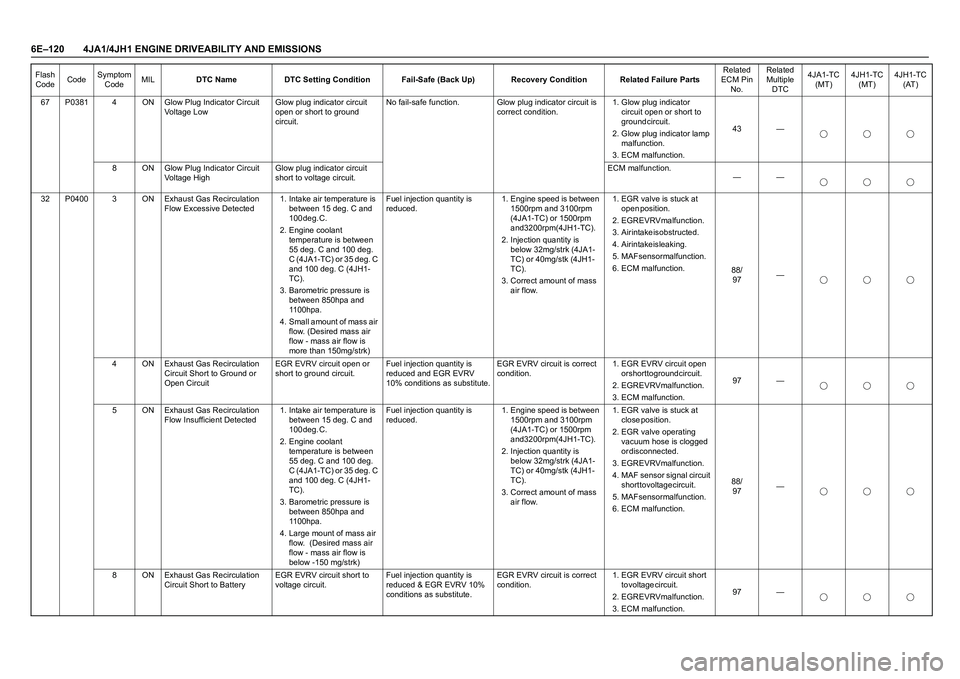
6E–120 4JA1/4JH1 ENGINE DRIVEABILITY AND EMISSIONS
67 P0381 4 ON Glow Plug Indicator Circuit
Voltage LowGlow plug indicator circuit
open or short to ground
circuit.No fail-safe function. Glow plug indicator circuit is
correct condition.1. Glow plug indicator
circuit open or short to
g r o u n d c i r c u i t .
2. Glow plug indicator lamp
m a l f u n c t i o n .
3. ECM malfunction.43 —
8 ON Glow Plug Indicator Circuit
Voltage HighGlow plug indicator circuit
short to voltage circuit.ECM malfunction.
——
32 P0400 3 ON Exhaust Gas Recirculation
Flow Excessive Detected1. Intake air temperature is
between 15 deg. C and
1 0 0 d e g . C .
2. Engine coolant
temperature is between
55 deg. C and 100 deg.
C (4JA1-TC) or 35 deg. C
and 100 deg. C (4JH1-
T C ) .
3. Barometric pressure is
between 850hpa and
1 1 0 0 h p a .
4. Small amount of mass air
flow. (Desired mass air
flow - mass air flow is
more than 150mg/strk)Fuel injection quantity is
reduced. 1. Engine speed is between
1500rpm and 3100rpm
(4JA1-TC) or 1500rpm
and 3200rpm (4JH1-TC).
2. Injection quantity is
below 32mg/strk (4JA1-
TC) or 40mg/stk (4JH1-
T C ) .
3. Correct amount of mass
air flow.1. EGR valve is stuck at
o p e n p o s i t i o n .
2. EGR EVRV malfunction.
3 . A i r i n t a k e i s o b s t r u c t e d .
4. Air intake is leaking.
5. MAF sensor malfunction.
6. ECM malfunction.
8 8 /
97—
4 ON Exhaust Gas Recirculation
Circuit Short to Ground or
Open CircuitEGR EVRV circuit open or
short to ground circuit.Fuel injection quantity is
reduced and EGR EVRV
10% conditions as substitute.EGR EVRV circuit is correct
condition.1. EGR EVRV circuit open
or short to ground circuit.
2. EGR EVRV malfunction.
3. ECM malfunction.97 —
5 ON Exhaust Gas Recirculation
Flow Insufficient Detected1. Intake air temperature is
between 15 deg. C and
100 deg. C.
2. Engine coolant
temperature is between
55 deg. C and 100 deg.
C (4JA1-TC) or 35 deg. C
and 100 deg. C (4JH1-
T C ) .
3. Barometric pressure is
between 850hpa and
1 1 0 0 h p a .
4. Large mount of mass air
flow. (Desired mass air
flow - mass air flow is
below -150 mg/strk)Fuel injection quantity is
reduced. 1. Engine speed is between
1500rpm and 3100rpm
(4JA1-TC) or 1500rpm
and 3200rpm (4JH1-TC).
2. Injection quantity is
below 32mg/strk (4JA1-
TC) or 40mg/stk (4JH1-
T C ) .
3. Correct amount of mass
air flow.1. EGR valve is stuck at
c l o s e p o s i t i o n .
2. EGR valve operating
vacuum hose is clogged
or disconnected.
3. EGR EVRV malfunction.
4. MAF sensor signal circuit
short to voltage circuit.
5. MAF sensor malfunction.
6. ECM malfunction.8 8 /
97—
8 ON Exhaust Gas Recirculation
Circuit Short to BatteryEGR EVRV circuit short to
voltage circuit.Fuel injection quantity is
reduced & EGR EVRV 10%
conditions as substitute.EGR EVRV circuit is correct
condition.1. EGR EVRV circuit short
t o v o l t a g e c i r c u i t .
2. EGR EVRV malfunction.
3. ECM malfunction.97 — Flash
CodeCodeSymptom
CodeMILDTC Name DTC Setting Condition Fail-Safe (Back Up) Recovery Condition Related Failure PartsRelated
ECM Pin
No.Related
Multiple
DTC4JA1-TC
(MT)4JH1-TC
(MT)4JH1-TC
(AT)
Page 1496 of 4264
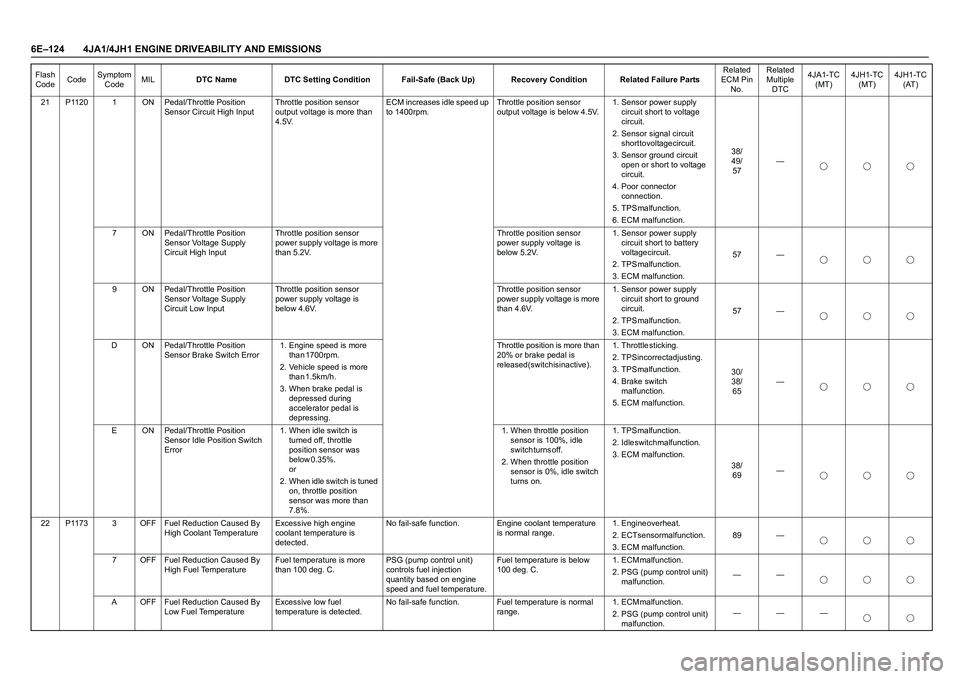
6E–124 4JA1/4JH1 ENGINE DRIVEABILITY AND EMISSIONS
21 P1120 1 ON Pedal/Throttle Position
Sensor Circuit High InputThrottle position sensor
output voltage is more than
4.5V.ECM increases idle speed up
to 1400rpm.Throttle position sensor
output voltage is below 4.5V.1. Sensor power supply
circuit short to voltage
c i r c u i t .
2. Sensor signal circuit
short to voltage circuit.
3. Sensor ground circuit
open or short to voltage
c i r c u i t .
4. Poor connector
c o n n e c t i o n .
5 . T P S m a l f u n c t i o n .
6. ECM malfunction.3 8 /
4 9 /
57—
7 ON Pedal/Throttle Position
Sensor Voltage Supply
Circuit High InputThrottle position sensor
power supply voltage is more
than 5.2V.Throttle position sensor
power supply voltage is
below 5.2V.1. Sensor power supply
circuit short to battery
voltage circuit.
2 . T P S m a l f u n c t i o n .
3. ECM malfunction.57 —
9 ON Pedal/Throttle Position
Sensor Voltage Supply
Circuit Low InputThrottle position sensor
power supply voltage is
below 4.6V.Throttle position sensor
power supply voltage is more
than 4.6V.1. Sensor power supply
circuit short to ground
c i r c u i t .
2 . T P S m a l f u n c t i o n .
3. ECM malfunction.57 —
D ON Pedal/Throttle Position
Sensor Brake Switch Error1. Engine speed is more
t h a n 1 7 0 0 r p m .
2. Vehicle speed is more
t h a n 1 . 5 k m / h .
3. When brake pedal is
depressed during
accelerator pedal is
d e p r e s s i n g . Throttle position is more than
20% or brake pedal is
released (switch is inactive). 1 . T h r o t t l e s t i c k i n g .
2. TPS incorrect adjusting.
3 . T P S m a l f u n c t i o n .
4. Brake switch
m a l f u n c t i o n .
5. ECM malfunction.3 0 /
3 8 /
65—
E ON Pedal/Throttle Position
Sensor Idle Position Switch
Error1. When idle switch is
turned off, throttle
position sensor was
b e l o w 0 . 3 5 % .
o r
2. When idle switch is tuned
on, throttle position
sensor was more than
7.8%.1. When throttle position
sensor is 100%, idle
s w i t c h t u r n s o f f .
2. When throttle position
sensor is 0%, idle switch
turns on.1 . T P S m a l f u n c t i o n .
2. Idle switch malfunction.
3. ECM malfunction.
3 8 /
69—
22 P1173 3 OFF Fuel Reduction Caused By
High Coolant TemperatureExcessive high engine
coolant temperature is
detected.No fail-safe function. Engine coolant temperature
is normal range.1 . E n g i n e o v e r h e a t .
2. ECT sensor malfunction.
3. ECM malfunction.89 —
7 OFF Fuel Reduction Caused By
High Fuel TemperatureFuel temperature is more
than 100 deg. C.PSG (pump control unit)
controls fuel injection
quantity based on engine
speed and fuel temperature.Fuel temperature is below
100 deg. C.1 . E C M m a l f u n c t i o n .
2. PSG (pump control unit)
malfunction.——
A OFF Fuel Reduction Caused By
Low Fuel TemperatureExcessive low fuel
temperature is detected.No fail-safe function. Fuel temperature is normal
range.1 . E C M m a l f u n c t i o n .
2. PSG (pump control unit)
malfunction.——— Flash
CodeCodeSymptom
CodeMILDTC Name DTC Setting Condition Fail-Safe (Back Up) Recovery Condition Related Failure PartsRelated
ECM Pin
No.Related
Multiple
DTC4JA1-TC
(MT)4JH1-TC
(MT)4JH1-TC
(AT)
Page 1532 of 4264
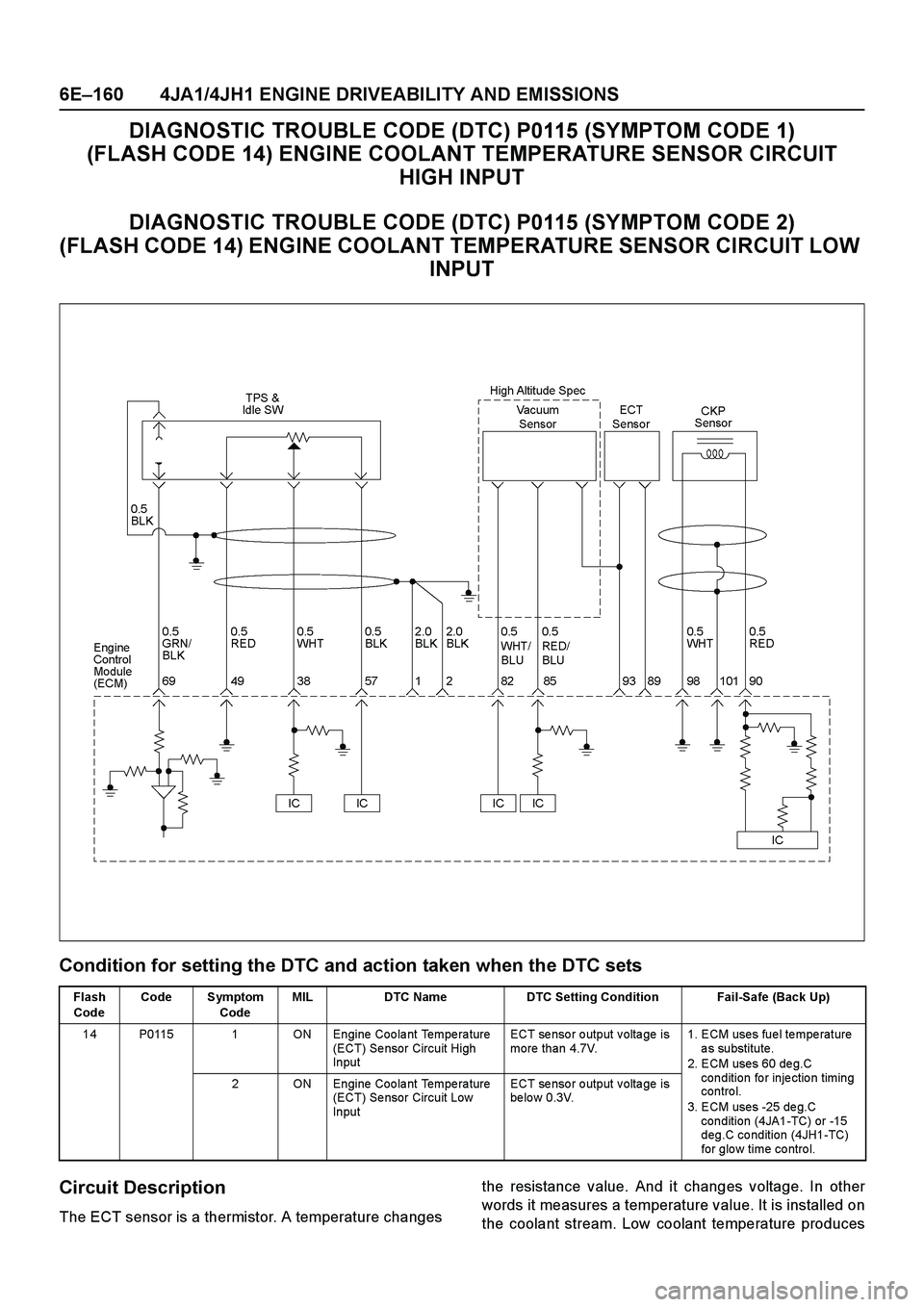
6E–160 4JA1/4JH1 ENGINE DRIVEABILITY AND EMISSIONS
DIAGNOSTIC TROUBLE CODE (DTC) P0115 (SYMPTOM CODE 1)
(FLASH CODE 14) ENGINE COOLANT TEMPERATURE SENSOR CIRCUIT
HIGH INPUT
DIAGNOSTIC TROUBLE CODE (DTC) P0115 (SYMPTOM CODE 2)
(FLASH CODE 14) ENGINE COOLANT TEMPERATURE SENSOR CIRCUIT LOW
INPUT
Condition for setting the DTC and action taken when the DTC sets
Circuit Description
The ECT sensor is a thermistor. A temperature changesthe resistance value. And it changes voltage. In other
words it measures a temperature value. It is installed on
the coolant stream. Low coolant temperature produces
Flash
CodeCode Symptom
CodeMIL DTC Name DTC Setting Condition Fail-Safe (Back Up)
14 P0115 1 ON Engine Coolant Temperature
(ECT) Se nsor Circuit High
InputECT sensor output voltage is
more than 4.7V.1. ECM uses fue l te mpe rature
as substitute.
2. ECM uses 60 de g.C
condition for injection timing
contro l.
3. ECM uses -25 de g.C
condition (4JA1-TC) or -15
deg.C condition (4JH1-TC)
for glo w time co ntro l. 2 ON Engine Coolant Temperature
(ECT) Se nsor Circuit Low
InputECT sensor output voltage is
be lo w 0.3V.
Page 1533 of 4264
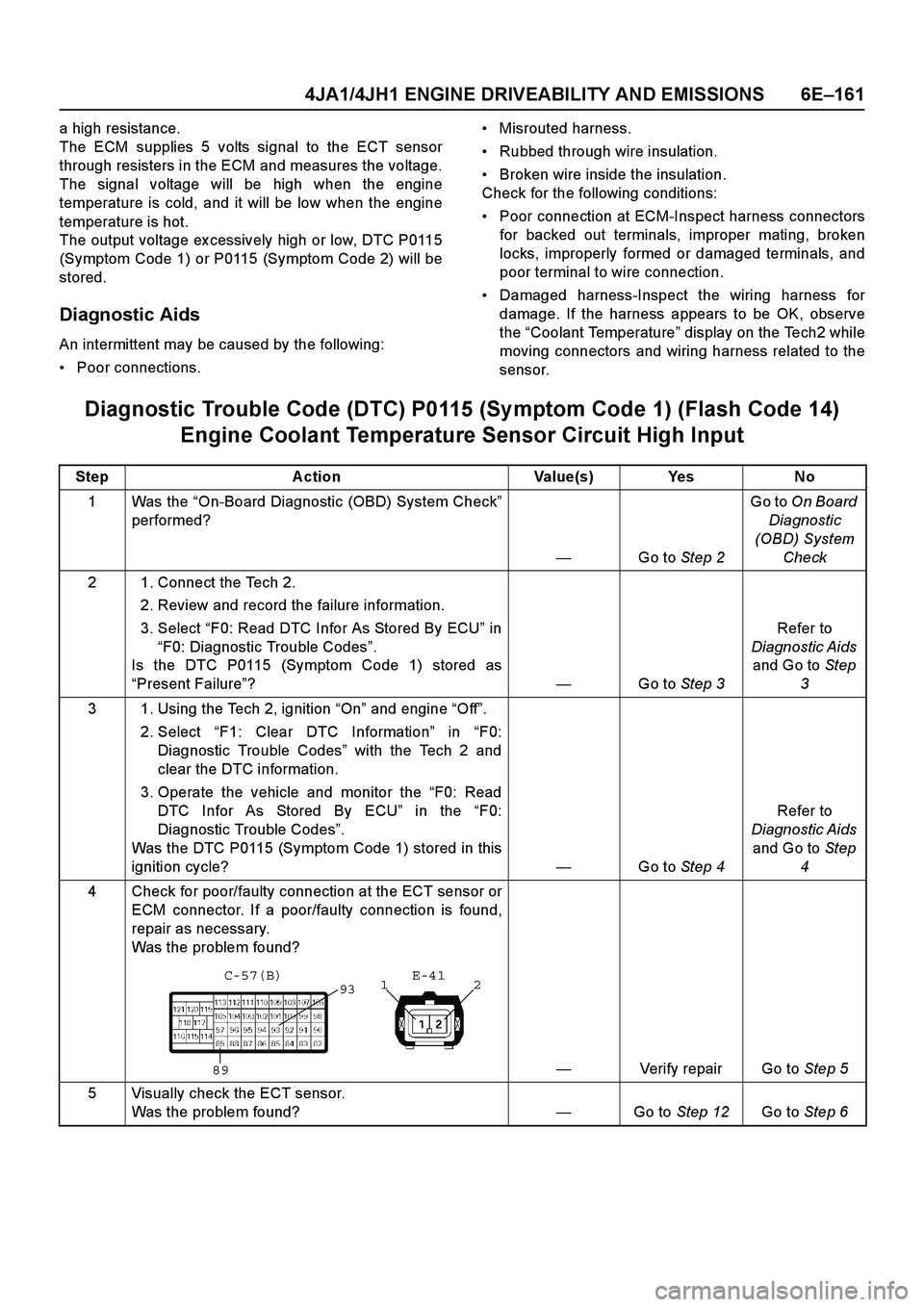
4JA1/4JH1 ENGINE DRIVEABILITY AND EMISSIONS 6E –161
a high resistance.
The ECM supplies 5 volts signal to the ECT sensor
through resisters in the ECM and measures the voltage.
The signal voltage will be high when the engine
temperature is cold, and it will be low when the engine
temperature is hot.
The output voltage ex cessively high or low, DTC P0115
(Symptom Code 1) or P0115 (Symptom Code 2) will be
stored.
Diagnostic Aids
An intermittent may be caused by the following:
Poor connections.
Misrouted harness.
Rubbed through wire insulation.
Broken wire inside the insulation.
Check for the following conditions:
Poor connection at ECM-Inspect harness connectors
for backed out terminals, improper mating, broken
locks, improperly formed or damaged terminals, and
poor terminal to wire connection.
Damaged harness-Inspect the wiring harness for
damage. If the harness appears to be OK, observe
the “Coolant Temperature ” display on the Tech2 while
moving connectors and wiring harness related to the
sensor.
Diagnostic Trouble Code (DTC) P0115 (Sy mptom Code 1) (Flash Code 14)
Engine Coolant Temperature Sensor Circuit High Input
Step Action Value(s) Yes No
1Was the “On-Board Diagnostic (OBD) System Check ”
performed?
— Go to Step 2 Go to
On Board
Diagnostic
(OBD) System Check
2 1. Connect the Tech 2. 2. Review and record the failure information.
3. Select “F0: Read DTC Infor As Stored By ECU ” in
“ F0: Diagnostic Trouble Codes ”.
Is the DTC P0115 (Symptom Code 1) stored as
“ Present Failure ”? —Go to Step 3 Refer to
Diagnostic Aids and Go to Step
3
3 1. Using the Tech 2, ignition “On ” and engine “Off ”.
2. Select “F1: Clear DTC Information ” in “F0:
Diagnostic Trouble Codes ” with the Tech 2 and
clear the DTC information.
3. Operate the vehicle and monitor the “F0: Read
DTC Infor As Stored By ECU ” in the “F0:
Diagnostic Trouble Codes ”.
Was the DTC P0115 (Symptom Code 1) stored in this
ignition cycle? —Go to Step 4 Refer to
Diagnostic Aids and Go to Step
4
4 Check for poor/faulty connection at the ECT sensor or ECM connector. If a poor/faulty connection is found,
repair as necessary.
Was the problem found?
— Verify repair Go to Step 5
5 Visually check the ECT sensor. Was the problem found? —Go to Step 12 Go to Step 6
932
1
89 E-41
C-57(B)
Page 1537 of 4264
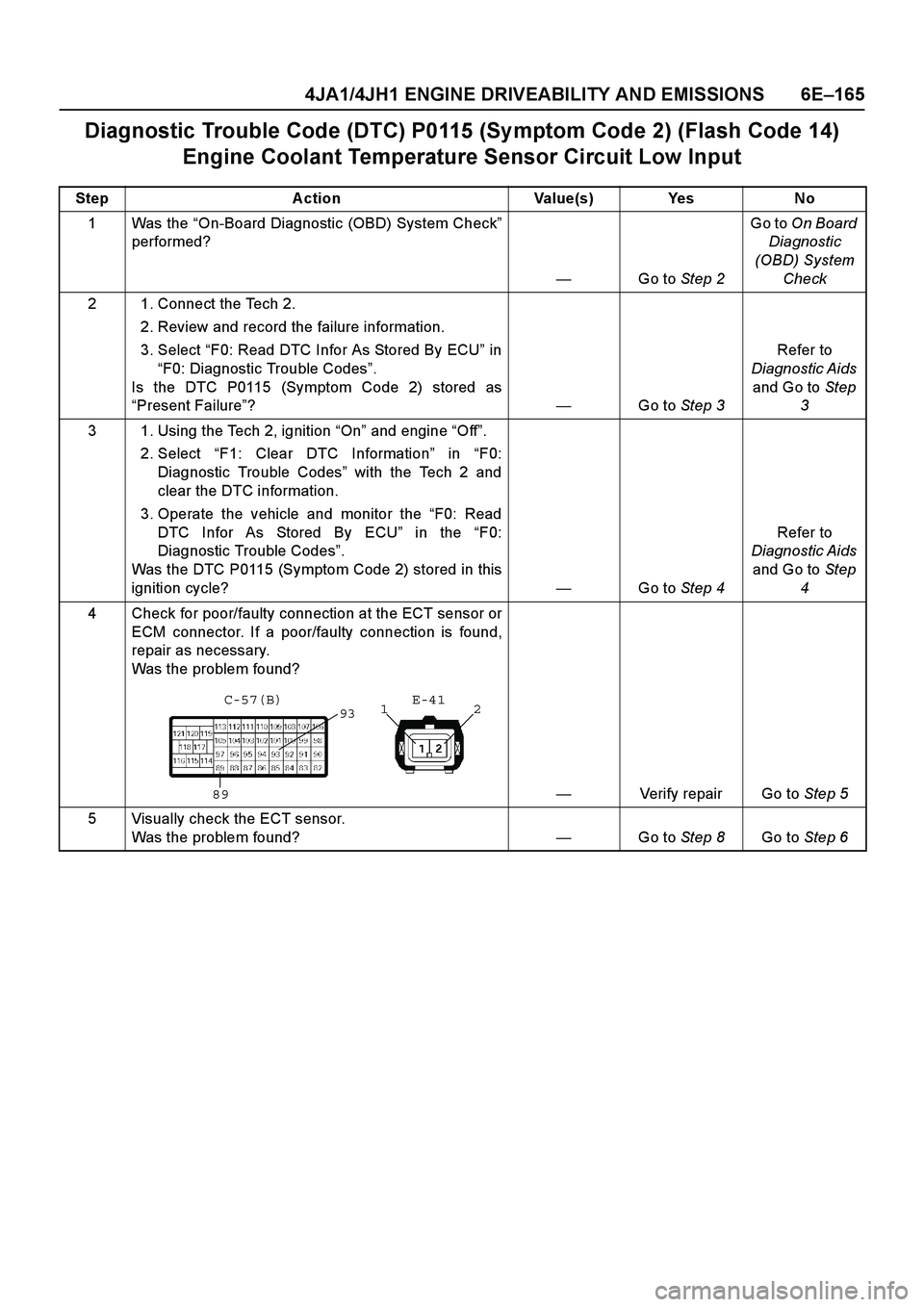
4JA1/4JH1 ENGINE DRIVEABILITY AND EMISSIONS 6E –165
Diagnostic Trouble Code (DTC) P0115 (Sy mptom Code 2) (Flash Code 14)
Engine Coolant Temperature Sensor Circuit Low Input
Step Action Value(s) Yes No
1Was the “On-Board Diagnostic (OBD) System Check ”
performed?
— Go to Step 2 Go to
On Board
Diagnostic
(OBD) System Check
2 1. Connect the Tech 2. 2. Review and record the failure information.
3. Select “F0: Read DTC Infor As Stored By ECU ” in
“ F0: Diagnostic Trouble Codes ”.
Is the DTC P0115 (Symptom Code 2) stored as
“ Present Failure ”? —Go to Step 3 Refer to
Diagnostic Aids and Go to Step
3
3 1. Using the Tech 2, ignition “On ” and engine “Off ”.
2. Select “F1: Clear DTC Information ” in “F0:
Diagnostic Trouble Codes ” with the Tech 2 and
clear the DTC information.
3. Operate the vehicle and monitor the “F0: Read
DTC Infor As Stored By ECU ” in the “F0:
Diagnostic Trouble Codes ”.
Was the DTC P0115 (Symptom Code 2) stored in this
ignition cycle? —Go to Step 4 Refer to
Diagnostic Aids and Go to Step
4
4 Check for poor/faulty connection at the ECT sensor or ECM connector. If a poor/faulty connection is found,
repair as necessary.
Was the problem found?
— Verify repair Go to Step 5
5 Visually check the ECT sensor. Was the problem found? —Go to Step 8 Go to Step 6
932
1
89 E-41
C-57(B)
Page 1551 of 4264
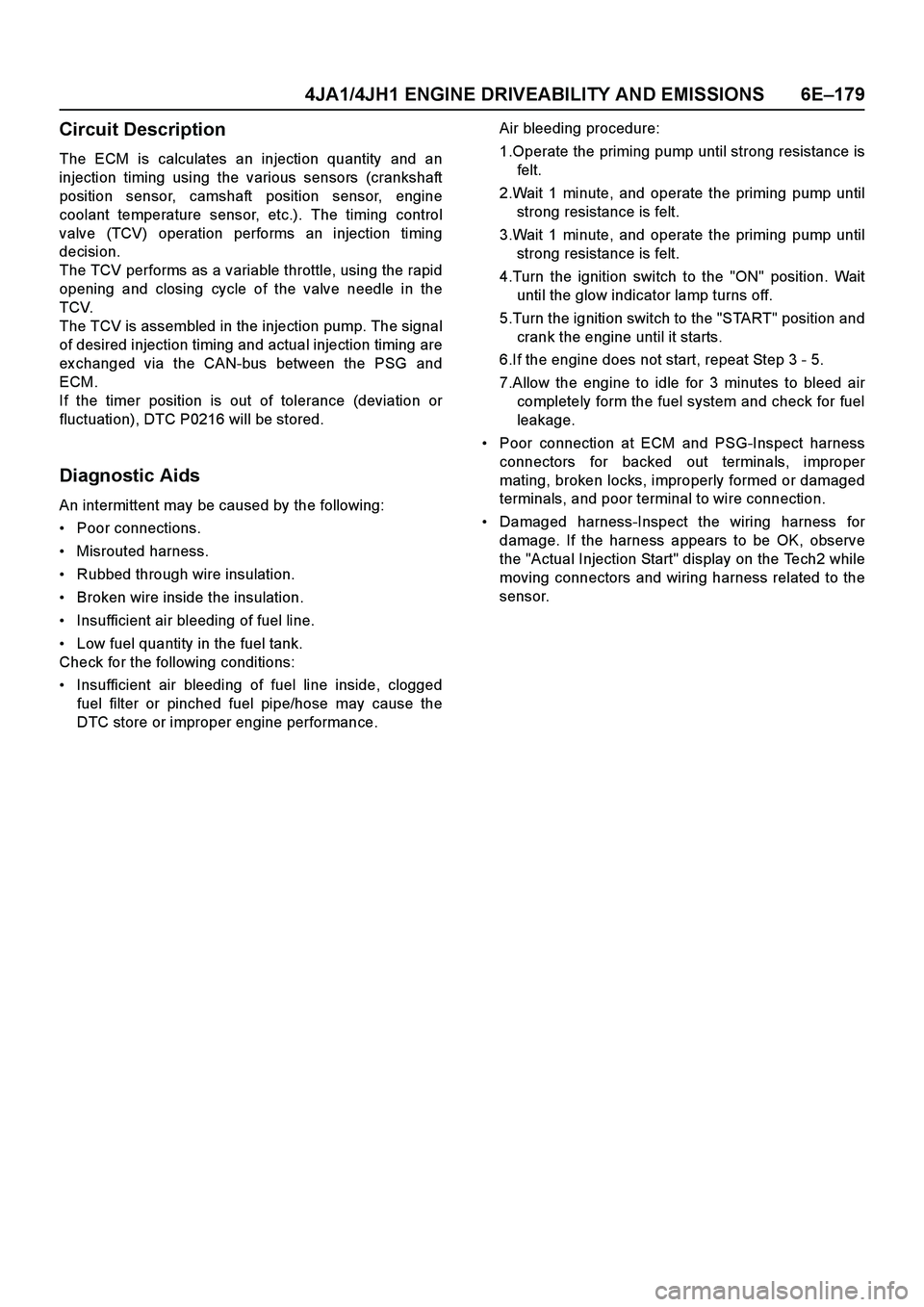
4JA1/4JH1 ENGINE DRIVEABILITY AND EMISSIONS 6E–179
Circuit Description
The ECM is calculates an injection quantity and an
injection timing using the various sensors (crankshaft
position sensor, camshaft position sensor, engine
coolant temperature sensor, etc.). The timing control
valve (TCV) operation performs an injection timing
decision.
The TCV performs as a variable throttle, using the rapid
opening and closing cycle of the valve needle in the
TCV.
The TCV is assembled in the injection pump. The signal
of desired injection timing and actual injection timing are
ex changed via the CAN-bus between the PSG and
ECM.
If the timer position is out of tolerance (deviation or
fluctuation), DTC P0216 will be stored.
Diagnostic Aids
An intermittent may be caused by the following:
Poor connections.
Misrouted harness.
Rubbed through wire insulation.
Broken wire inside the insulation.
Insufficient air bleeding of fuel line.
Low fuel quantity in the fuel tank.
Check for the following conditions:
Insufficient air bleeding of fuel line inside, clogged
fuel filter or pinched fuel pipe/hose may cause the
DTC store or improper engine performance.Air bleeding procedure:
1.Operate the priming pump until strong resistance is
felt.
2.Wait 1 minute, and operate the priming pump until
strong resistance is felt.
3.Wait 1 minute, and operate the priming pump until
strong resistance is felt.
4.Turn the ignition switch to the "ON" position. Wait
until the glow indicator lamp turns off.
5.Turn the ignition switch to the "START" position and
crank the engine until it starts.
6.If the engine does not start, repeat Step 3 - 5.
7.Allow the engine to idle for 3 minutes to bleed air
completely form the fuel system and check for fuel
leakage.
Poor connection at ECM and PSG-Inspect harness
connectors for backed out terminals, improper
mating, broken locks, improperly formed or damaged
terminals, and poor terminal to wire connection.
Damaged harness-Inspect the wiring harness for
damage. If the harness appears to be OK, observe
the "Actual Injection Start" display on the Tech2 while
moving connectors and wiring harness related to the
sensor.